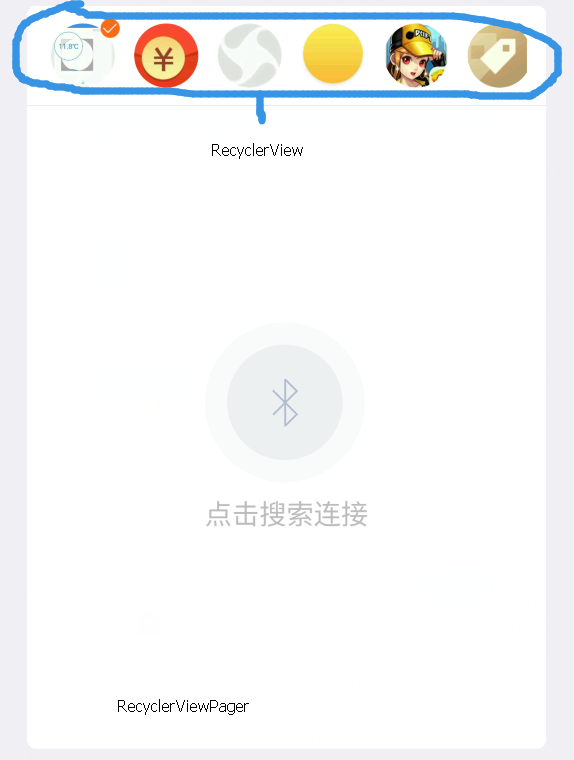I followed the steps to configure and create the simple example using the Github documentation.
Main Activity XML
<?xml version="1.0" encoding="utf-8"?>
<RelativeLayout xmlns:android="http://schemas.android.com/apk/res/android"
xmlns:tools="http://schemas.android.com/tools"
android:layout_width="match_parent"
android:layout_height="match_parent"
xmlns:app="http://schemas.android.com/apk/res-auto"
android:paddingBottom="@dimen/activity_vertical_margin"
android:paddingLeft="@dimen/activity_horizontal_margin"
android:paddingRight="@dimen/activity_horizontal_margin"
android:paddingTop="@dimen/activity_vertical_margin"
tools:context="com.stackoverflow.recyclerviewstack.MainActivity">
<com.lsjwzh.widget.recyclerviewpager.RecyclerViewPager
android:id="@+id/list"
android:layout_width="match_parent"
android:layout_height="match_parent"
android:paddingLeft="1dp"
android:paddingRight="1dp"
app:rvp_triggerOffset="0.1"
app:rvp_singlePageFling="true"
android:clipToPadding="false"
/>
</RelativeLayout>
Main Activiy class
package com.stackoverflow.recyclerviewstack;
import android.support.v7.app.AppCompatActivity;
import android.os.Bundle;
import android.support.v7.widget.LinearLayoutManager;
import com.lsjwzh.widget.recyclerviewpager.RecyclerViewPager;
public class MainActivity extends AppCompatActivity {
RecyclerAdapter mAdapter;
RecyclerViewPager mRecycler;
@Override
protected void onCreate(Bundle savedInstanceState) {
super.onCreate(savedInstanceState);
setContentView(R.layout.activity_main);
mRecycler = (RecyclerViewPager) findViewById(R.id.list);
// setLayoutManager like normal RecyclerView, you do not need to change any thing.
LinearLayoutManager layout = new LinearLayoutManager(this, LinearLayoutManager.VERTICAL, false);
mRecycler.setLayoutManager(layout);
//set adapter
//You just need to implements ViewPageAdapter by yourself like a normal RecyclerView.Adpater.
mAdapter = new RecyclerAdapter(ItemListGenerator.generateCollection(15, "OutItem "));
mRecycler.setAdapter(mAdapter);
}
}
RecyclerAdapter
public class RecyclerAdapter extends RecyclerView.Adapter<RecyclerAdapter.ViewHolder> {
List<String> collection;
public RecyclerAdapter(List<String> collection) {
this.collection = collection;
}
public class ViewHolder extends RecyclerView.ViewHolder {
public TextView item;
RecyclerView mInnerRecycler;
public ViewHolder(View view) {
super(view);
item = (TextView) view.findViewById(R.id.title);
mInnerRecycler = (RecyclerView) view.findViewById(R.id.innerRecycler);
LinearLayoutManager layout = new LinearLayoutManager(view.getContext(),
LinearLayoutManager.HORIZONTAL, false);
mInnerRecycler.setLayoutManager(layout);
mInnerRecycler.setAdapter(new InnerAdapter());
}
}
@Override
public ViewHolder onCreateViewHolder(ViewGroup parent, int viewType) {
Context context = parent.getContext();
LayoutInflater inflater = LayoutInflater.from(context);
View view = inflater.inflate(R.layout.outer_collection, parent, false);
ViewHolder viewHolder = new ViewHolder(view);
return viewHolder;
}
@Override
public void onBindViewHolder(ViewHolder holder, int position) {
if(position < 0 || position > getItemCount()) return;
String itemString = collection.get(position);
holder.item.setText(itemString);
}
@Override
public int getItemCount() {
return collection.size();
}
}
the layout use by RecyclerViewPager to create ViewHolder
The ViewHolder use the layout outer_collection:
<?xml version="1.0" encoding="utf-8"?>
<LinearLayout xmlns:android="http://schemas.android.com/apk/res/android"
android:orientation="vertical" android:layout_width="match_parent"
android:layout_height="match_parent">
<TextView
android:id="@+id/title"
android:layout_width="wrap_content"
android:layout_height="wrap_content"
android:padding="5dip"
android:layout_margin="2dip"
android:background="@color/colorPrimary"/>
<android.support.v7.widget.RecyclerView
android:id="@+id/innerRecycler"
android:layout_width="wrap_content"
android:layout_height="wrap_content"/>
</LinearLayout>
The InnerAdapter
public class InnerAdapter extends RecyclerView.Adapter<InnerAdapter.ViewHolder> {
List<String> collection;
public InnerAdapter() {
this.collection = ItemListGenerator.generateCollection(15, "Inner ");
}
public class ViewHolder extends RecyclerView.ViewHolder {
public TextView item;
public ViewHolder(View itemView) {
super(itemView);
item = (TextView) itemView.findViewById(R.id.item);
}
}
@Override
public ViewHolder onCreateViewHolder(ViewGroup parent, int viewType) {
Context context = parent.getContext();
LayoutInflater inflater = LayoutInflater.from(context);
View view = inflater.inflate(R.layout.simple_item, parent, false);
ViewHolder viewHolder = new ViewHolder(view);
return viewHolder;
}
@Override
public void onBindViewHolder(ViewHolder holder, int position) {
if(position < 0 || position > getItemCount()) return;
holder.item.setText(collection.get(position));
}
@Override
public int getItemCount() {
return collection.size();
}
}
Tip
For the RecyclerViewPager I used this orientation:
LinearLayoutManager layout = new LinearLayoutManager(this, LinearLayoutManager.VERTICAL, false);
And for the RecyclerView inside this one:
LinearLayoutManager layout = new LinearLayoutManager(view.getContext(), LinearLayoutManager.HORIZONTAL, false);
If you use VERTICAL in the PagerView you can navigate in the horizontal collection or change to HORIZONTAL the PagerView orientation and you can scroll your inside items in the VERTICAL orientation.
You have to evaluate how do you want to use it. I hope this code help with your problem and also to rethink your design. Maybe is not a good practice or UX use the same orientation for both containers. I am not a UX expert.
I will like to be more helpful.

